capstone project introduction assignment
VerifiedAdded on 2021/02/20
|10
|3510
|185
AI Summary
Contribute Materials
Your contribution can guide someone’s learning journey. Share your
documents today.

CAPSTONE PROJECT
Secure Best Marks with AI Grader
Need help grading? Try our AI Grader for instant feedback on your assignments.
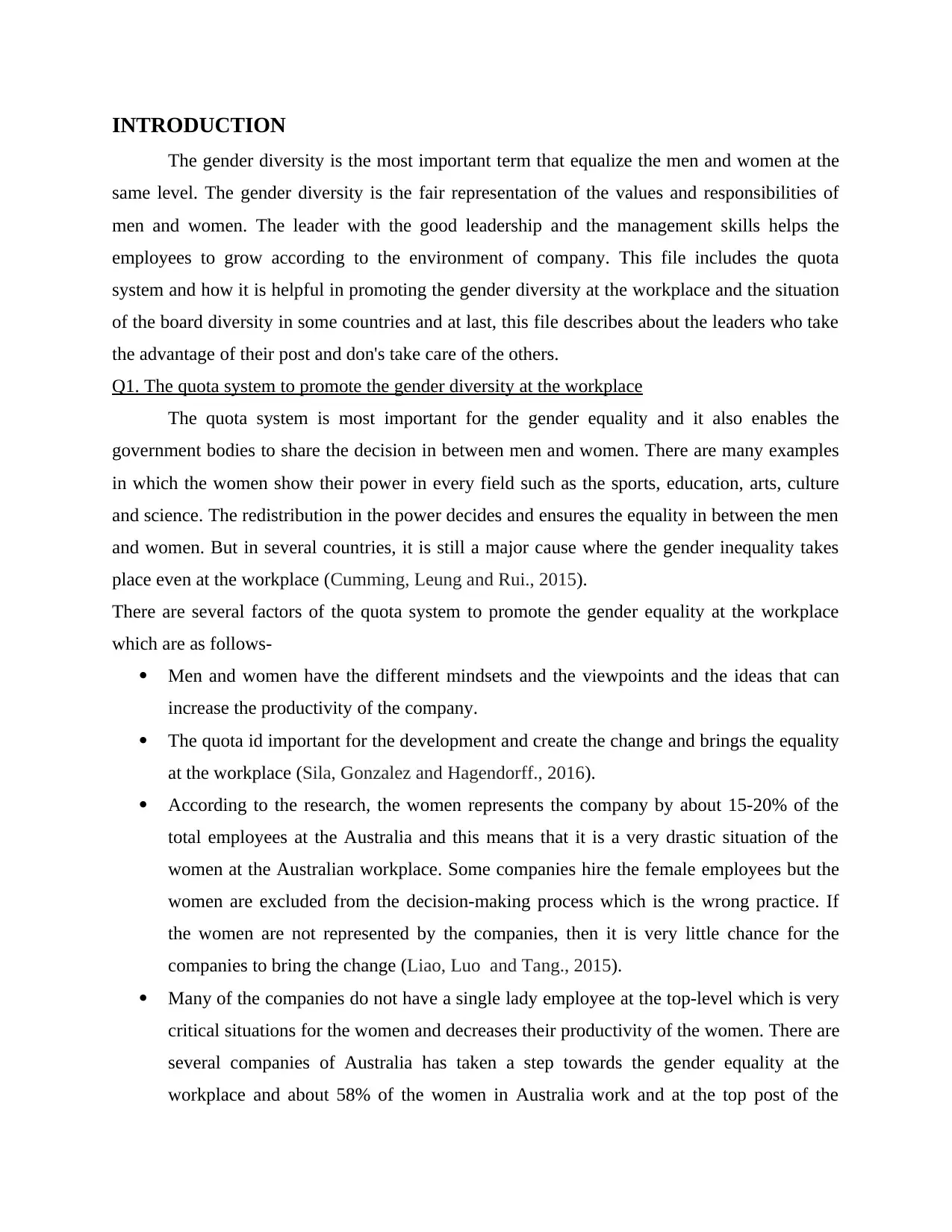
INTRODUCTION
The gender diversity is the most important term that equalize the men and women at the
same level. The gender diversity is the fair representation of the values and responsibilities of
men and women. The leader with the good leadership and the management skills helps the
employees to grow according to the environment of company. This file includes the quota
system and how it is helpful in promoting the gender diversity at the workplace and the situation
of the board diversity in some countries and at last, this file describes about the leaders who take
the advantage of their post and don's take care of the others.
Q1. The quota system to promote the gender diversity at the workplace
The quota system is most important for the gender equality and it also enables the
government bodies to share the decision in between men and women. There are many examples
in which the women show their power in every field such as the sports, education, arts, culture
and science. The redistribution in the power decides and ensures the equality in between the men
and women. But in several countries, it is still a major cause where the gender inequality takes
place even at the workplace (Cumming, Leung and Rui., 2015).
There are several factors of the quota system to promote the gender equality at the workplace
which are as follows-
Men and women have the different mindsets and the viewpoints and the ideas that can
increase the productivity of the company.
The quota id important for the development and create the change and brings the equality
at the workplace (Sila, Gonzalez and Hagendorff., 2016).
According to the research, the women represents the company by about 15-20% of the
total employees at the Australia and this means that it is a very drastic situation of the
women at the Australian workplace. Some companies hire the female employees but the
women are excluded from the decision-making process which is the wrong practice. If
the women are not represented by the companies, then it is very little chance for the
companies to bring the change (Liao, Luo and Tang., 2015).
Many of the companies do not have a single lady employee at the top-level which is very
critical situations for the women and decreases their productivity of the women. There are
several companies of Australia has taken a step towards the gender equality at the
workplace and about 58% of the women in Australia work and at the top post of the
The gender diversity is the most important term that equalize the men and women at the
same level. The gender diversity is the fair representation of the values and responsibilities of
men and women. The leader with the good leadership and the management skills helps the
employees to grow according to the environment of company. This file includes the quota
system and how it is helpful in promoting the gender diversity at the workplace and the situation
of the board diversity in some countries and at last, this file describes about the leaders who take
the advantage of their post and don's take care of the others.
Q1. The quota system to promote the gender diversity at the workplace
The quota system is most important for the gender equality and it also enables the
government bodies to share the decision in between men and women. There are many examples
in which the women show their power in every field such as the sports, education, arts, culture
and science. The redistribution in the power decides and ensures the equality in between the men
and women. But in several countries, it is still a major cause where the gender inequality takes
place even at the workplace (Cumming, Leung and Rui., 2015).
There are several factors of the quota system to promote the gender equality at the workplace
which are as follows-
Men and women have the different mindsets and the viewpoints and the ideas that can
increase the productivity of the company.
The quota id important for the development and create the change and brings the equality
at the workplace (Sila, Gonzalez and Hagendorff., 2016).
According to the research, the women represents the company by about 15-20% of the
total employees at the Australia and this means that it is a very drastic situation of the
women at the Australian workplace. Some companies hire the female employees but the
women are excluded from the decision-making process which is the wrong practice. If
the women are not represented by the companies, then it is very little chance for the
companies to bring the change (Liao, Luo and Tang., 2015).
Many of the companies do not have a single lady employee at the top-level which is very
critical situations for the women and decreases their productivity of the women. There are
several companies of Australia has taken a step towards the gender equality at the
workplace and about 58% of the women in Australia work and at the top post of the
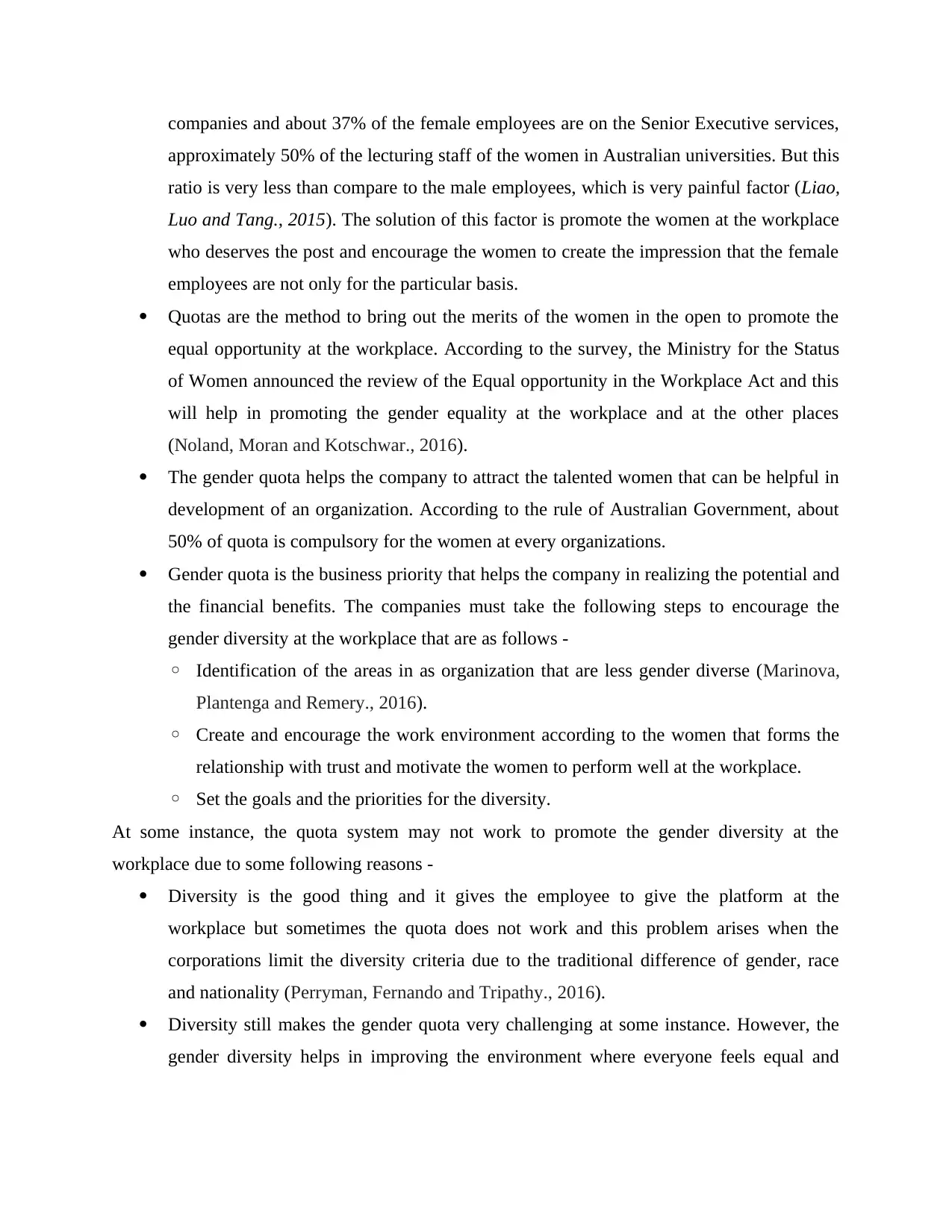
companies and about 37% of the female employees are on the Senior Executive services,
approximately 50% of the lecturing staff of the women in Australian universities. But this
ratio is very less than compare to the male employees, which is very painful factor (Liao,
Luo and Tang., 2015). The solution of this factor is promote the women at the workplace
who deserves the post and encourage the women to create the impression that the female
employees are not only for the particular basis.
Quotas are the method to bring out the merits of the women in the open to promote the
equal opportunity at the workplace. According to the survey, the Ministry for the Status
of Women announced the review of the Equal opportunity in the Workplace Act and this
will help in promoting the gender equality at the workplace and at the other places
(Noland, Moran and Kotschwar., 2016).
The gender quota helps the company to attract the talented women that can be helpful in
development of an organization. According to the rule of Australian Government, about
50% of quota is compulsory for the women at every organizations.
Gender quota is the business priority that helps the company in realizing the potential and
the financial benefits. The companies must take the following steps to encourage the
gender diversity at the workplace that are as follows -
◦ Identification of the areas in as organization that are less gender diverse (Marinova,
Plantenga and Remery., 2016).
◦ Create and encourage the work environment according to the women that forms the
relationship with trust and motivate the women to perform well at the workplace.
◦ Set the goals and the priorities for the diversity.
At some instance, the quota system may not work to promote the gender diversity at the
workplace due to some following reasons -
Diversity is the good thing and it gives the employee to give the platform at the
workplace but sometimes the quota does not work and this problem arises when the
corporations limit the diversity criteria due to the traditional difference of gender, race
and nationality (Perryman, Fernando and Tripathy., 2016).
Diversity still makes the gender quota very challenging at some instance. However, the
gender diversity helps in improving the environment where everyone feels equal and
approximately 50% of the lecturing staff of the women in Australian universities. But this
ratio is very less than compare to the male employees, which is very painful factor (Liao,
Luo and Tang., 2015). The solution of this factor is promote the women at the workplace
who deserves the post and encourage the women to create the impression that the female
employees are not only for the particular basis.
Quotas are the method to bring out the merits of the women in the open to promote the
equal opportunity at the workplace. According to the survey, the Ministry for the Status
of Women announced the review of the Equal opportunity in the Workplace Act and this
will help in promoting the gender equality at the workplace and at the other places
(Noland, Moran and Kotschwar., 2016).
The gender quota helps the company to attract the talented women that can be helpful in
development of an organization. According to the rule of Australian Government, about
50% of quota is compulsory for the women at every organizations.
Gender quota is the business priority that helps the company in realizing the potential and
the financial benefits. The companies must take the following steps to encourage the
gender diversity at the workplace that are as follows -
◦ Identification of the areas in as organization that are less gender diverse (Marinova,
Plantenga and Remery., 2016).
◦ Create and encourage the work environment according to the women that forms the
relationship with trust and motivate the women to perform well at the workplace.
◦ Set the goals and the priorities for the diversity.
At some instance, the quota system may not work to promote the gender diversity at the
workplace due to some following reasons -
Diversity is the good thing and it gives the employee to give the platform at the
workplace but sometimes the quota does not work and this problem arises when the
corporations limit the diversity criteria due to the traditional difference of gender, race
and nationality (Perryman, Fernando and Tripathy., 2016).
Diversity still makes the gender quota very challenging at some instance. However, the
gender diversity helps in improving the environment where everyone feels equal and
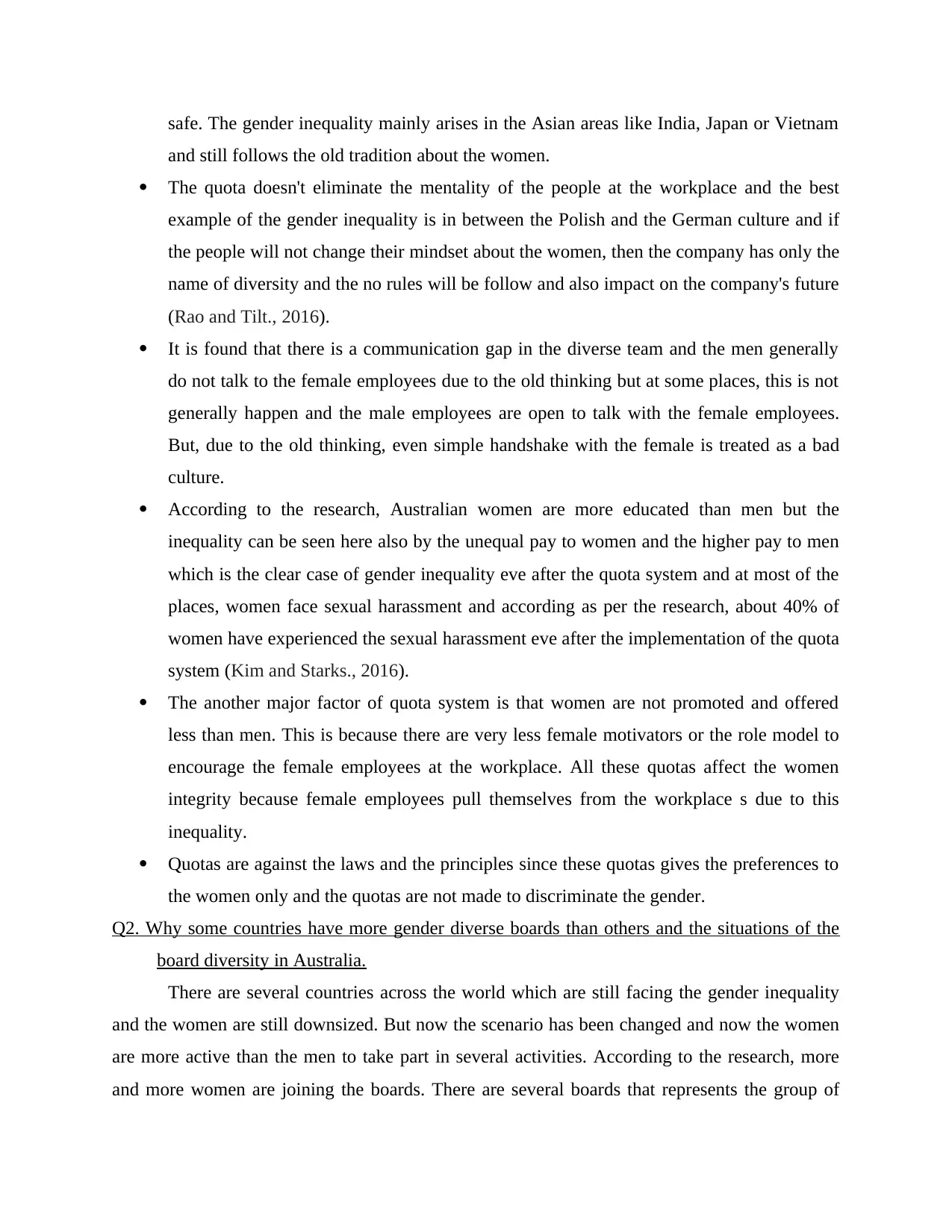
safe. The gender inequality mainly arises in the Asian areas like India, Japan or Vietnam
and still follows the old tradition about the women.
The quota doesn't eliminate the mentality of the people at the workplace and the best
example of the gender inequality is in between the Polish and the German culture and if
the people will not change their mindset about the women, then the company has only the
name of diversity and the no rules will be follow and also impact on the company's future
(Rao and Tilt., 2016).
It is found that there is a communication gap in the diverse team and the men generally
do not talk to the female employees due to the old thinking but at some places, this is not
generally happen and the male employees are open to talk with the female employees.
But, due to the old thinking, even simple handshake with the female is treated as a bad
culture.
According to the research, Australian women are more educated than men but the
inequality can be seen here also by the unequal pay to women and the higher pay to men
which is the clear case of gender inequality eve after the quota system and at most of the
places, women face sexual harassment and according as per the research, about 40% of
women have experienced the sexual harassment eve after the implementation of the quota
system (Kim and Starks., 2016).
The another major factor of quota system is that women are not promoted and offered
less than men. This is because there are very less female motivators or the role model to
encourage the female employees at the workplace. All these quotas affect the women
integrity because female employees pull themselves from the workplace s due to this
inequality.
Quotas are against the laws and the principles since these quotas gives the preferences to
the women only and the quotas are not made to discriminate the gender.
Q2. Why some countries have more gender diverse boards than others and the situations of the
board diversity in Australia.
There are several countries across the world which are still facing the gender inequality
and the women are still downsized. But now the scenario has been changed and now the women
are more active than the men to take part in several activities. According to the research, more
and more women are joining the boards. There are several boards that represents the group of
and still follows the old tradition about the women.
The quota doesn't eliminate the mentality of the people at the workplace and the best
example of the gender inequality is in between the Polish and the German culture and if
the people will not change their mindset about the women, then the company has only the
name of diversity and the no rules will be follow and also impact on the company's future
(Rao and Tilt., 2016).
It is found that there is a communication gap in the diverse team and the men generally
do not talk to the female employees due to the old thinking but at some places, this is not
generally happen and the male employees are open to talk with the female employees.
But, due to the old thinking, even simple handshake with the female is treated as a bad
culture.
According to the research, Australian women are more educated than men but the
inequality can be seen here also by the unequal pay to women and the higher pay to men
which is the clear case of gender inequality eve after the quota system and at most of the
places, women face sexual harassment and according as per the research, about 40% of
women have experienced the sexual harassment eve after the implementation of the quota
system (Kim and Starks., 2016).
The another major factor of quota system is that women are not promoted and offered
less than men. This is because there are very less female motivators or the role model to
encourage the female employees at the workplace. All these quotas affect the women
integrity because female employees pull themselves from the workplace s due to this
inequality.
Quotas are against the laws and the principles since these quotas gives the preferences to
the women only and the quotas are not made to discriminate the gender.
Q2. Why some countries have more gender diverse boards than others and the situations of the
board diversity in Australia.
There are several countries across the world which are still facing the gender inequality
and the women are still downsized. But now the scenario has been changed and now the women
are more active than the men to take part in several activities. According to the research, more
and more women are joining the boards. There are several boards that represents the group of
Secure Best Marks with AI Grader
Need help grading? Try our AI Grader for instant feedback on your assignments.
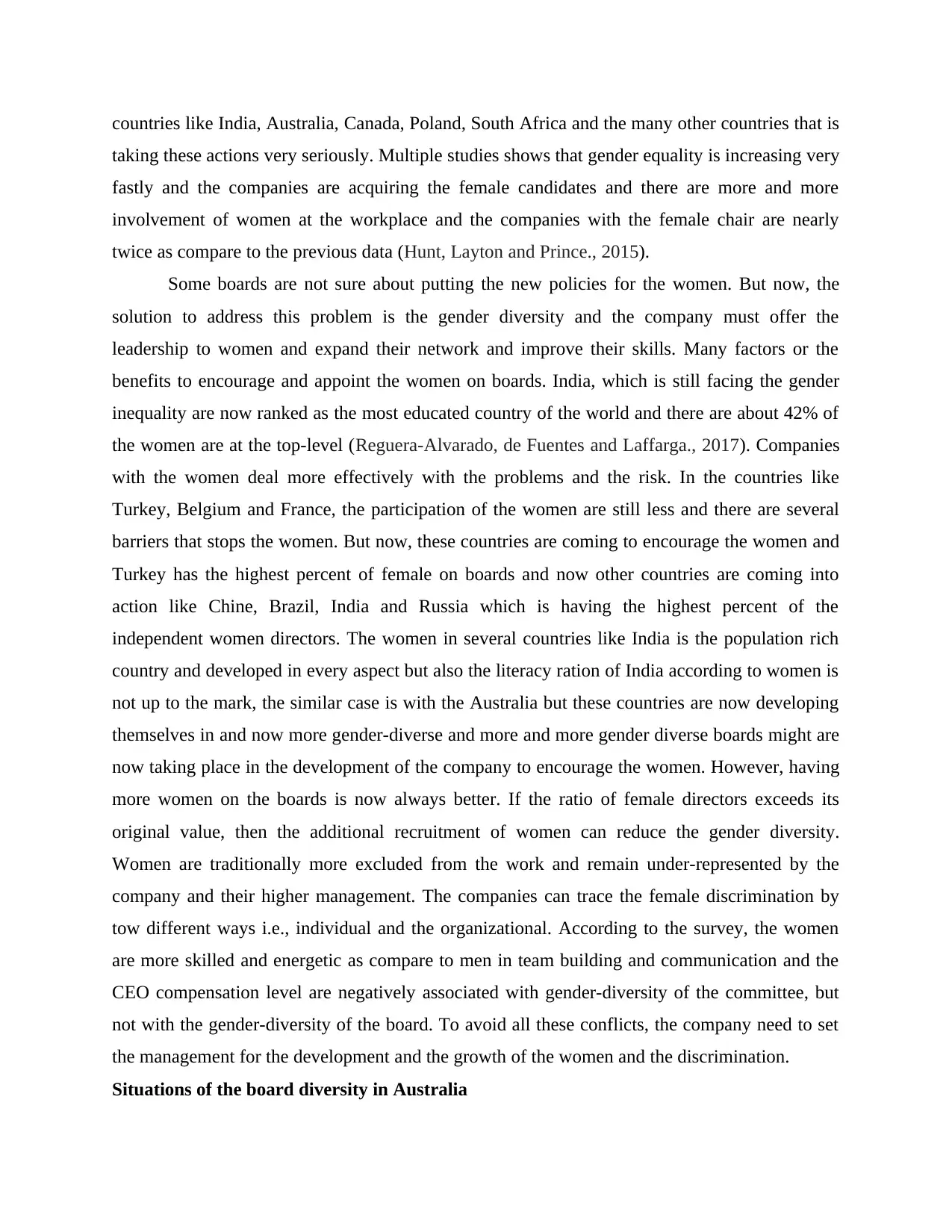
countries like India, Australia, Canada, Poland, South Africa and the many other countries that is
taking these actions very seriously. Multiple studies shows that gender equality is increasing very
fastly and the companies are acquiring the female candidates and there are more and more
involvement of women at the workplace and the companies with the female chair are nearly
twice as compare to the previous data (Hunt, Layton and Prince., 2015).
Some boards are not sure about putting the new policies for the women. But now, the
solution to address this problem is the gender diversity and the company must offer the
leadership to women and expand their network and improve their skills. Many factors or the
benefits to encourage and appoint the women on boards. India, which is still facing the gender
inequality are now ranked as the most educated country of the world and there are about 42% of
the women are at the top-level (Reguera-Alvarado, de Fuentes and Laffarga., 2017). Companies
with the women deal more effectively with the problems and the risk. In the countries like
Turkey, Belgium and France, the participation of the women are still less and there are several
barriers that stops the women. But now, these countries are coming to encourage the women and
Turkey has the highest percent of female on boards and now other countries are coming into
action like Chine, Brazil, India and Russia which is having the highest percent of the
independent women directors. The women in several countries like India is the population rich
country and developed in every aspect but also the literacy ration of India according to women is
not up to the mark, the similar case is with the Australia but these countries are now developing
themselves in and now more gender-diverse and more and more gender diverse boards might are
now taking place in the development of the company to encourage the women. However, having
more women on the boards is now always better. If the ratio of female directors exceeds its
original value, then the additional recruitment of women can reduce the gender diversity.
Women are traditionally more excluded from the work and remain under-represented by the
company and their higher management. The companies can trace the female discrimination by
tow different ways i.e., individual and the organizational. According to the survey, the women
are more skilled and energetic as compare to men in team building and communication and the
CEO compensation level are negatively associated with gender-diversity of the committee, but
not with the gender-diversity of the board. To avoid all these conflicts, the company need to set
the management for the development and the growth of the women and the discrimination.
Situations of the board diversity in Australia
taking these actions very seriously. Multiple studies shows that gender equality is increasing very
fastly and the companies are acquiring the female candidates and there are more and more
involvement of women at the workplace and the companies with the female chair are nearly
twice as compare to the previous data (Hunt, Layton and Prince., 2015).
Some boards are not sure about putting the new policies for the women. But now, the
solution to address this problem is the gender diversity and the company must offer the
leadership to women and expand their network and improve their skills. Many factors or the
benefits to encourage and appoint the women on boards. India, which is still facing the gender
inequality are now ranked as the most educated country of the world and there are about 42% of
the women are at the top-level (Reguera-Alvarado, de Fuentes and Laffarga., 2017). Companies
with the women deal more effectively with the problems and the risk. In the countries like
Turkey, Belgium and France, the participation of the women are still less and there are several
barriers that stops the women. But now, these countries are coming to encourage the women and
Turkey has the highest percent of female on boards and now other countries are coming into
action like Chine, Brazil, India and Russia which is having the highest percent of the
independent women directors. The women in several countries like India is the population rich
country and developed in every aspect but also the literacy ration of India according to women is
not up to the mark, the similar case is with the Australia but these countries are now developing
themselves in and now more gender-diverse and more and more gender diverse boards might are
now taking place in the development of the company to encourage the women. However, having
more women on the boards is now always better. If the ratio of female directors exceeds its
original value, then the additional recruitment of women can reduce the gender diversity.
Women are traditionally more excluded from the work and remain under-represented by the
company and their higher management. The companies can trace the female discrimination by
tow different ways i.e., individual and the organizational. According to the survey, the women
are more skilled and energetic as compare to men in team building and communication and the
CEO compensation level are negatively associated with gender-diversity of the committee, but
not with the gender-diversity of the board. To avoid all these conflicts, the company need to set
the management for the development and the growth of the women and the discrimination.
Situations of the board diversity in Australia
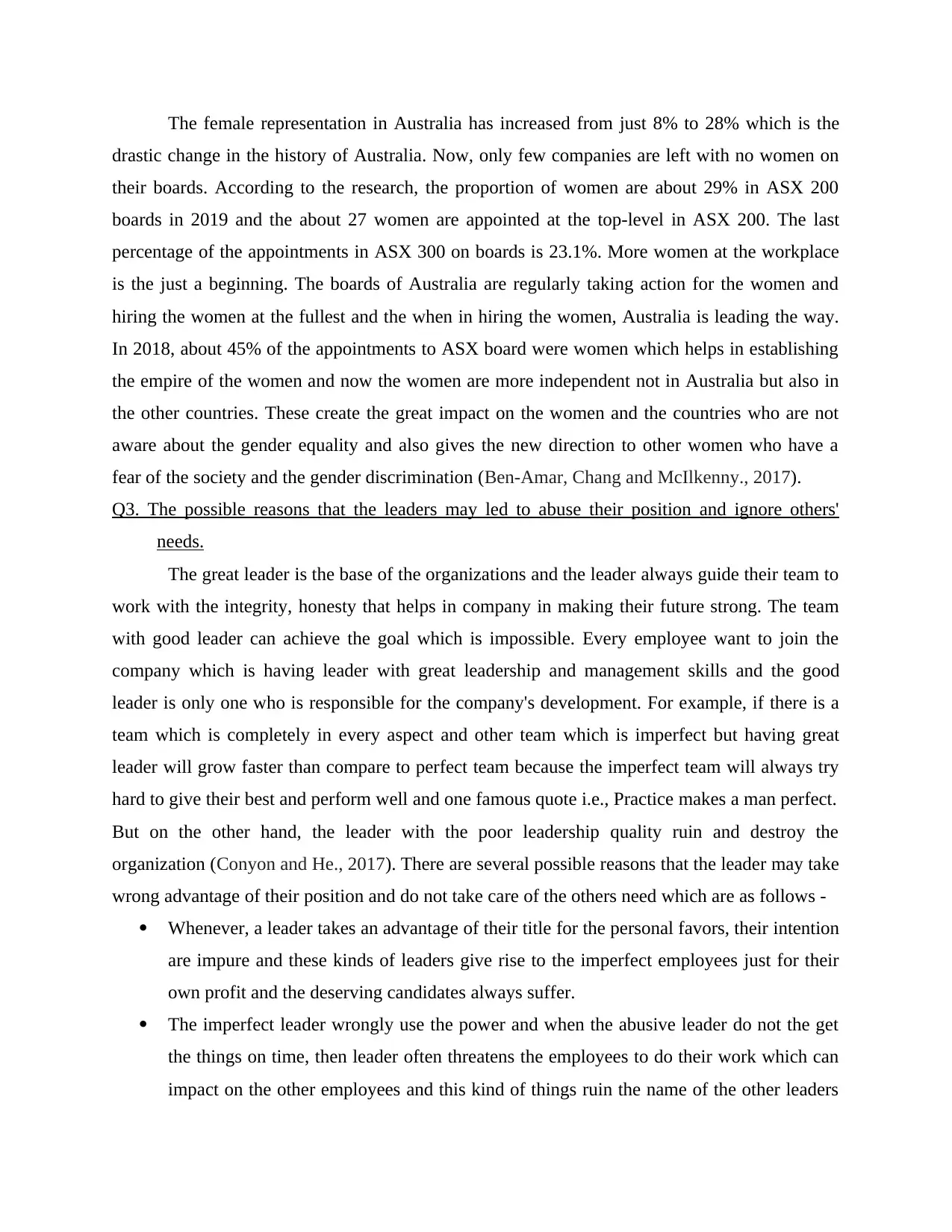
The female representation in Australia has increased from just 8% to 28% which is the
drastic change in the history of Australia. Now, only few companies are left with no women on
their boards. According to the research, the proportion of women are about 29% in ASX 200
boards in 2019 and the about 27 women are appointed at the top-level in ASX 200. The last
percentage of the appointments in ASX 300 on boards is 23.1%. More women at the workplace
is the just a beginning. The boards of Australia are regularly taking action for the women and
hiring the women at the fullest and the when in hiring the women, Australia is leading the way.
In 2018, about 45% of the appointments to ASX board were women which helps in establishing
the empire of the women and now the women are more independent not in Australia but also in
the other countries. These create the great impact on the women and the countries who are not
aware about the gender equality and also gives the new direction to other women who have a
fear of the society and the gender discrimination (Ben-Amar, Chang and McIlkenny., 2017).
Q3. The possible reasons that the leaders may led to abuse their position and ignore others'
needs.
The great leader is the base of the organizations and the leader always guide their team to
work with the integrity, honesty that helps in company in making their future strong. The team
with good leader can achieve the goal which is impossible. Every employee want to join the
company which is having leader with great leadership and management skills and the good
leader is only one who is responsible for the company's development. For example, if there is a
team which is completely in every aspect and other team which is imperfect but having great
leader will grow faster than compare to perfect team because the imperfect team will always try
hard to give their best and perform well and one famous quote i.e., Practice makes a man perfect.
But on the other hand, the leader with the poor leadership quality ruin and destroy the
organization (Conyon and He., 2017). There are several possible reasons that the leader may take
wrong advantage of their position and do not take care of the others need which are as follows -
Whenever, a leader takes an advantage of their title for the personal favors, their intention
are impure and these kinds of leaders give rise to the imperfect employees just for their
own profit and the deserving candidates always suffer.
The imperfect leader wrongly use the power and when the abusive leader do not the get
the things on time, then leader often threatens the employees to do their work which can
impact on the other employees and this kind of things ruin the name of the other leaders
drastic change in the history of Australia. Now, only few companies are left with no women on
their boards. According to the research, the proportion of women are about 29% in ASX 200
boards in 2019 and the about 27 women are appointed at the top-level in ASX 200. The last
percentage of the appointments in ASX 300 on boards is 23.1%. More women at the workplace
is the just a beginning. The boards of Australia are regularly taking action for the women and
hiring the women at the fullest and the when in hiring the women, Australia is leading the way.
In 2018, about 45% of the appointments to ASX board were women which helps in establishing
the empire of the women and now the women are more independent not in Australia but also in
the other countries. These create the great impact on the women and the countries who are not
aware about the gender equality and also gives the new direction to other women who have a
fear of the society and the gender discrimination (Ben-Amar, Chang and McIlkenny., 2017).
Q3. The possible reasons that the leaders may led to abuse their position and ignore others'
needs.
The great leader is the base of the organizations and the leader always guide their team to
work with the integrity, honesty that helps in company in making their future strong. The team
with good leader can achieve the goal which is impossible. Every employee want to join the
company which is having leader with great leadership and management skills and the good
leader is only one who is responsible for the company's development. For example, if there is a
team which is completely in every aspect and other team which is imperfect but having great
leader will grow faster than compare to perfect team because the imperfect team will always try
hard to give their best and perform well and one famous quote i.e., Practice makes a man perfect.
But on the other hand, the leader with the poor leadership quality ruin and destroy the
organization (Conyon and He., 2017). There are several possible reasons that the leader may take
wrong advantage of their position and do not take care of the others need which are as follows -
Whenever, a leader takes an advantage of their title for the personal favors, their intention
are impure and these kinds of leaders give rise to the imperfect employees just for their
own profit and the deserving candidates always suffer.
The imperfect leader wrongly use the power and when the abusive leader do not the get
the things on time, then leader often threatens the employees to do their work which can
impact on the other employees and this kind of things ruin the name of the other leaders
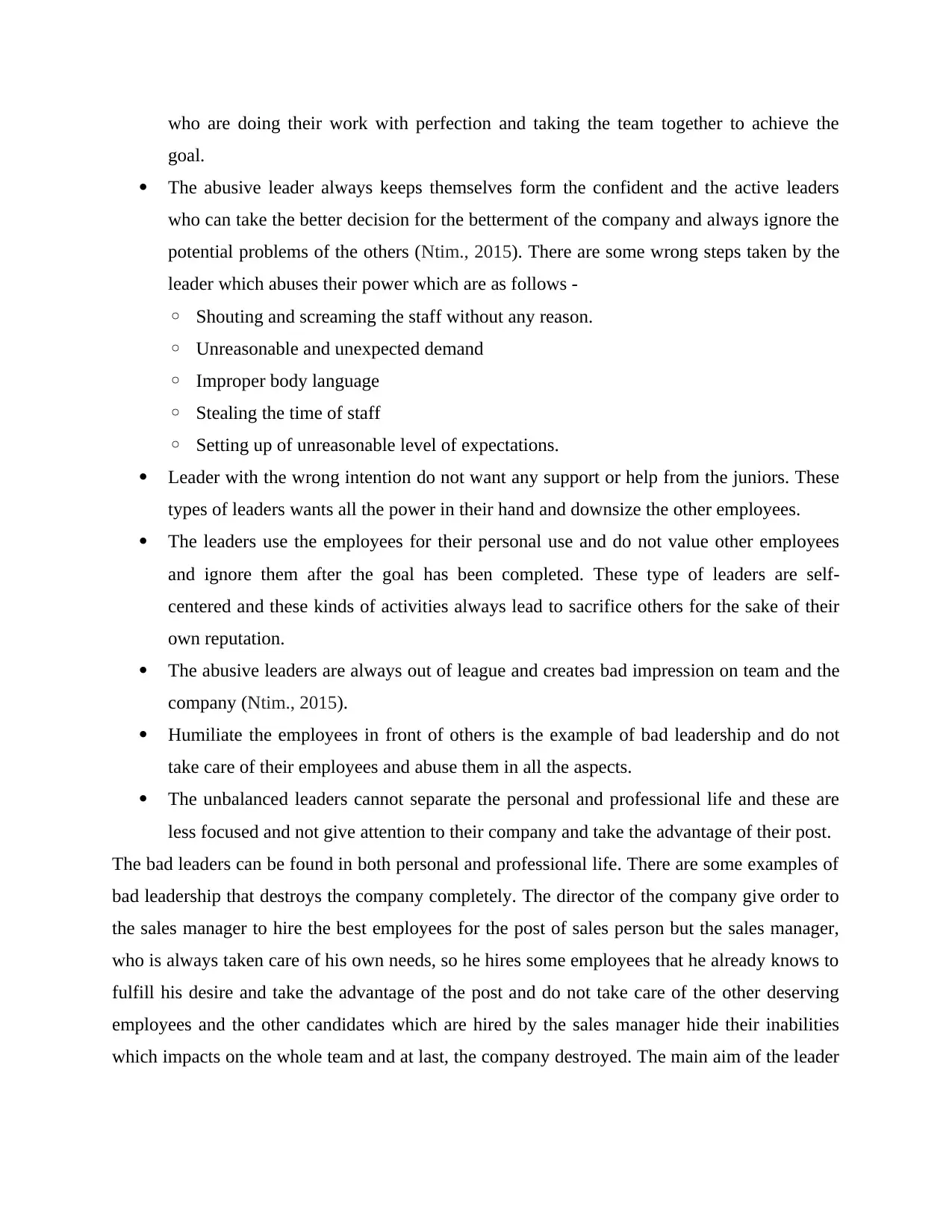
who are doing their work with perfection and taking the team together to achieve the
goal.
The abusive leader always keeps themselves form the confident and the active leaders
who can take the better decision for the betterment of the company and always ignore the
potential problems of the others (Ntim., 2015). There are some wrong steps taken by the
leader which abuses their power which are as follows -
◦ Shouting and screaming the staff without any reason.
◦ Unreasonable and unexpected demand
◦ Improper body language
◦ Stealing the time of staff
◦ Setting up of unreasonable level of expectations.
Leader with the wrong intention do not want any support or help from the juniors. These
types of leaders wants all the power in their hand and downsize the other employees.
The leaders use the employees for their personal use and do not value other employees
and ignore them after the goal has been completed. These type of leaders are self-
centered and these kinds of activities always lead to sacrifice others for the sake of their
own reputation.
The abusive leaders are always out of league and creates bad impression on team and the
company (Ntim., 2015).
Humiliate the employees in front of others is the example of bad leadership and do not
take care of their employees and abuse them in all the aspects.
The unbalanced leaders cannot separate the personal and professional life and these are
less focused and not give attention to their company and take the advantage of their post.
The bad leaders can be found in both personal and professional life. There are some examples of
bad leadership that destroys the company completely. The director of the company give order to
the sales manager to hire the best employees for the post of sales person but the sales manager,
who is always taken care of his own needs, so he hires some employees that he already knows to
fulfill his desire and take the advantage of the post and do not take care of the other deserving
employees and the other candidates which are hired by the sales manager hide their inabilities
which impacts on the whole team and at last, the company destroyed. The main aim of the leader
goal.
The abusive leader always keeps themselves form the confident and the active leaders
who can take the better decision for the betterment of the company and always ignore the
potential problems of the others (Ntim., 2015). There are some wrong steps taken by the
leader which abuses their power which are as follows -
◦ Shouting and screaming the staff without any reason.
◦ Unreasonable and unexpected demand
◦ Improper body language
◦ Stealing the time of staff
◦ Setting up of unreasonable level of expectations.
Leader with the wrong intention do not want any support or help from the juniors. These
types of leaders wants all the power in their hand and downsize the other employees.
The leaders use the employees for their personal use and do not value other employees
and ignore them after the goal has been completed. These type of leaders are self-
centered and these kinds of activities always lead to sacrifice others for the sake of their
own reputation.
The abusive leaders are always out of league and creates bad impression on team and the
company (Ntim., 2015).
Humiliate the employees in front of others is the example of bad leadership and do not
take care of their employees and abuse them in all the aspects.
The unbalanced leaders cannot separate the personal and professional life and these are
less focused and not give attention to their company and take the advantage of their post.
The bad leaders can be found in both personal and professional life. There are some examples of
bad leadership that destroys the company completely. The director of the company give order to
the sales manager to hire the best employees for the post of sales person but the sales manager,
who is always taken care of his own needs, so he hires some employees that he already knows to
fulfill his desire and take the advantage of the post and do not take care of the other deserving
employees and the other candidates which are hired by the sales manager hide their inabilities
which impacts on the whole team and at last, the company destroyed. The main aim of the leader
Paraphrase This Document
Need a fresh take? Get an instant paraphrase of this document with our AI Paraphraser

to handle the team and improve their skills that can be beneficial for the growth and the
development of the company (Conyon and He., 2017).
There is one real life example which destroy the name of leadership that are as follows -
Heather Bresch (Mylan) is the best example of the bad leaders who falsely stated that Mylan
made only profit of $100 on each pack but the true was very different and the profit was very
high i.e., $166. Then Mylan decides to dive the fine of about $465 million to settle down the
problem. Just for the small profit, the company ruin their name and this is because of bad
leadership and the decision taken for their own profit na d take the advantage of their post and
this also impact on the employees future because sometimes the Government decide to close the
company for their wrongdoing (Conyon and He., 2017).
CONCLUSION
The whole file concludes that how the quota system promotes the gender diversity at the
workplace and the some possible situations about why some countries have more gender diverse
boards and the situation of the board diversity in Australia and the possible reasons that can ruin
the leadership by their bad behaviour and take the advantage of their post and do not take care of
others. This results in destroying the whole team as well as the company productivity. The
companies should encourage the women who have fear to face the problems of the society and
the organization need to make the laws for the gender diversity to equalize the men and the
women at every level.
development of the company (Conyon and He., 2017).
There is one real life example which destroy the name of leadership that are as follows -
Heather Bresch (Mylan) is the best example of the bad leaders who falsely stated that Mylan
made only profit of $100 on each pack but the true was very different and the profit was very
high i.e., $166. Then Mylan decides to dive the fine of about $465 million to settle down the
problem. Just for the small profit, the company ruin their name and this is because of bad
leadership and the decision taken for their own profit na d take the advantage of their post and
this also impact on the employees future because sometimes the Government decide to close the
company for their wrongdoing (Conyon and He., 2017).
CONCLUSION
The whole file concludes that how the quota system promotes the gender diversity at the
workplace and the some possible situations about why some countries have more gender diverse
boards and the situation of the board diversity in Australia and the possible reasons that can ruin
the leadership by their bad behaviour and take the advantage of their post and do not take care of
others. This results in destroying the whole team as well as the company productivity. The
companies should encourage the women who have fear to face the problems of the society and
the organization need to make the laws for the gender diversity to equalize the men and the
women at every level.

REFERENCES
Books and journals
Cumming, D., Leung, T.Y. and Rui, O., 2015. Gender diversity and securities fraud. Academy of
management Journal, 58(5), pp.1572-1593.
Sila, V., Gonzalez, A. and Hagendorff, J., 2016. Women on board: Does boardroom gender
diversity affect firm risk?.Journal of Corporate Finance, 36, pp.26-53.
Liao, L., Luo, L. and Tang, Q., 2015. Gender diversity, board independence, environmental
committee and greenhouse gas disclosure. The British Accounting Review, 47(4), pp.409-
424.
Noland, M., Moran, T. and Kotschwar, B.R., 2016. Is gender diversity profitable? Evidence from
a global survey. Peterson Institute for International Economics Working Paper, (16-3).
Marinova, J., Plantenga, J. and Remery, C., 2016. Gender diversity and firm performance:
Evidence from Dutch and Danish boardrooms. The International Journal of Human
Resource Management, 27(15), pp.1777-1790.
Perryman, A.A., Fernando, G.D. and Tripathy, A., 2016. Do gender differences persist? An
examination of gender diversity on firm performance, risk, and executive compensation.
Journal of Business Research, 69(2), pp.579-586.
Rao, K. and Tilt, C., 2016. Board composition and corporate social responsibility: The role of
diversity, gender, strategy and decision making. Journal of Business Ethics, 138(2),
pp.327-347.
Kim, D. and Starks, L.T., 2016. Gender diversity on corporate boards: Do women contribute
unique skills?. American Economic Review, 106(5), pp.267-71.
Hunt, V., Layton, D. and Prince, S., 2015. Diversity matters.McKinsey & Company, 1, pp.15-29.
Reguera-Alvarado, N., de Fuentes, P. and Laffarga, J., 2017. Does board gender diversity
influence financial performance? Evidence from Spain. Journal of Business Ethics,
141(2), pp.337-350.
Ben-Amar, W., Chang, M. and McIlkenny, P., 2017. Board gender diversity and corporate
response to sustainability initiatives: Evidence from the carbon disclosure project.Journal
of Business Ethics, 142(2), pp.369-383.
Conyon, M.J. and He, L., 2017. Firm performance and boardroom gender diversity: A quantile
regression approach.Journal of Business Research, 79, pp.198-211.
Ntim, C.G., 2015. Board diversity and organizational valuation: unravelling the effects of
ethnicity and gender.Journal of Management & Governance, 19(1), pp.167-195.
Books and journals
Cumming, D., Leung, T.Y. and Rui, O., 2015. Gender diversity and securities fraud. Academy of
management Journal, 58(5), pp.1572-1593.
Sila, V., Gonzalez, A. and Hagendorff, J., 2016. Women on board: Does boardroom gender
diversity affect firm risk?.Journal of Corporate Finance, 36, pp.26-53.
Liao, L., Luo, L. and Tang, Q., 2015. Gender diversity, board independence, environmental
committee and greenhouse gas disclosure. The British Accounting Review, 47(4), pp.409-
424.
Noland, M., Moran, T. and Kotschwar, B.R., 2016. Is gender diversity profitable? Evidence from
a global survey. Peterson Institute for International Economics Working Paper, (16-3).
Marinova, J., Plantenga, J. and Remery, C., 2016. Gender diversity and firm performance:
Evidence from Dutch and Danish boardrooms. The International Journal of Human
Resource Management, 27(15), pp.1777-1790.
Perryman, A.A., Fernando, G.D. and Tripathy, A., 2016. Do gender differences persist? An
examination of gender diversity on firm performance, risk, and executive compensation.
Journal of Business Research, 69(2), pp.579-586.
Rao, K. and Tilt, C., 2016. Board composition and corporate social responsibility: The role of
diversity, gender, strategy and decision making. Journal of Business Ethics, 138(2),
pp.327-347.
Kim, D. and Starks, L.T., 2016. Gender diversity on corporate boards: Do women contribute
unique skills?. American Economic Review, 106(5), pp.267-71.
Hunt, V., Layton, D. and Prince, S., 2015. Diversity matters.McKinsey & Company, 1, pp.15-29.
Reguera-Alvarado, N., de Fuentes, P. and Laffarga, J., 2017. Does board gender diversity
influence financial performance? Evidence from Spain. Journal of Business Ethics,
141(2), pp.337-350.
Ben-Amar, W., Chang, M. and McIlkenny, P., 2017. Board gender diversity and corporate
response to sustainability initiatives: Evidence from the carbon disclosure project.Journal
of Business Ethics, 142(2), pp.369-383.
Conyon, M.J. and He, L., 2017. Firm performance and boardroom gender diversity: A quantile
regression approach.Journal of Business Research, 79, pp.198-211.
Ntim, C.G., 2015. Board diversity and organizational valuation: unravelling the effects of
ethnicity and gender.Journal of Management & Governance, 19(1), pp.167-195.

1 out of 10
Related Documents
Your All-in-One AI-Powered Toolkit for Academic Success.
+13062052269
info@desklib.com
Available 24*7 on WhatsApp / Email
![[object Object]](/_next/static/media/star-bottom.7253800d.svg)
Unlock your academic potential
© 2024 | Zucol Services PVT LTD | All rights reserved.





